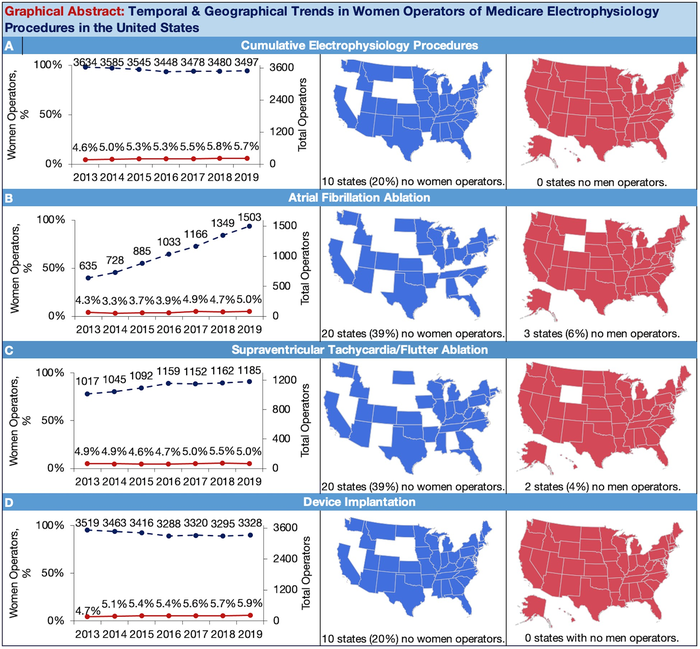Philadelphia, April 29, 2022 – Cardiovascular medicine is ranked among the lowest in terms of female representation in the United States, and cardiac electrophysiology is a predominantly male field. While women comprise 24% to 43% of trainees and 15% of general cardiologists and non-procedural cardiology specialists, only 12% of clinical electrophysiology trainees and 9% of board-certified electrophysiologists are women, according to a new report in Heart Rhythm, the official journal of the Heart Rhythm Society, the Cardiac Electrophysiology Society, and the Pediatric & Congenital Electrophysiology Society, published by Elsevier.

Credit: Heart Rhythm
Philadelphia, April 29, 2022 – Cardiovascular medicine is ranked among the lowest in terms of female representation in the United States, and cardiac electrophysiology is a predominantly male field. While women comprise 24% to 43% of trainees and 15% of general cardiologists and non-procedural cardiology specialists, only 12% of clinical electrophysiology trainees and 9% of board-certified electrophysiologists are women, according to a new report in Heart Rhythm, the official journal of the Heart Rhythm Society, the Cardiac Electrophysiology Society, and the Pediatric & Congenital Electrophysiology Society, published by Elsevier.
Not only is the representation of women compared to men in the electrophysiology workforce disparate and less than cardiology as a whole, but studies have also highlighted sex-based differences in salaries, Medicare reimbursements, and leadership of cardiovascular clinical trials.
“Our goal was to better define the representation of women in the electrophysiology workforce and what kind of progress, if any, has been made,” explained lead investigator Stacey J. Howell, MD, Section of Cardiac Electrophysiology, Division of Cardiovascular Medicine, University of California San Francisco, San Francisco, CA, USA. “We knew that women were poorly represented, but we did not know if that varied by specific electrophysiology procedure type or whether it had improved in recent years. It is a timely question since the importance of women in medicine, and broadly in the workforce, has garnered national attention recently.”
Investigators extracted data on the electrophysiology procedures performed during 2013-2019 from the Medicare Provider Utilization and Payment Database, a publicly available database that summarizes the medical procedures, services, and drugs provided to Medicare patients. They included the most common procedures: atrial fibrillation (AF) ablation, supraventricular tachycardia/atrial flutter ablation (SVT/AFL), and cardiac device implantation.
Results showed that, on average, annually between 2013-2019, only 5% (187) of the 3,524 electrophysiology operators included in the database were women. Procedure-specific analyses revealed a similarly low proportion of women electrophysiology operators across each procedure type. Despite a 137% increase in the total number of AF ablationists over the seven-year period, the proportion of women remained stagnant.
The number of SVT/AFL ablationists and device operators remained constant over time as did the proportion of women operators. In 2019, one-fifth of states in the US had no women electrophysiology operators who performed 10 or more of any given electrophysiology procedure annually, 20 states had no women who performed more than ten of either AF or AFL/ SVT ablations annually, and 10 states had no women device operators who performed more than 10 of any given type of device implantation annually.
During the study time period, the American College of Graduate Medical Education reported that while total electrophysiology trainees increased by 75%, the percentage of women electrophysiology trainees decreased by 3%.
“We hope that by better defining the gender disparity in electrophysiology, our study can highlight the need to recruit and retain more women in this subspeciality,” noted Dr. Howell. “I am starting out in my career in electrophysiology, and I hope that throughout my career as a field we collectively can address issues that uniquely impact women in order to improve the representation of women electrophysiologists.”
Dr. Howell reported that studies have shown that concordance between patient and physician gender (woman patient–woman physician) improves clinical outcomes. Increasing the proportion of women electrophysiologists, and therefore the number of women patients treated by women electrophysiologists, may positively influence patient outcomes.
Co-author Babak Nazer, MD, Knight Cardiovascular Institute, Oregon Health and Science University, Portland, OR, USA, added, “As a male electrophysiologist in a predominantly male field, I have had the privilege of working closely with several remarkable female colleagues in our field, including Dr. Cara Pellegrini and Dr. Stacey Howell. We hope that these findings, and future topics we plan to investigate, elucidate the barriers to growing female representation in our field, which I feel will benefit both our patients and ourselves.”
In an accompanying editorial, Kavisha Patel, MD, and Ulrika Birgersdotter-Green, MD, Section of Electrophysiology, Division of Cardiology, UC San Diego Health, San Diego, CA, USA, noted that cardiovascular medicine ranked among the lowest in terms of female representation, and that the third decennial Professional Life Survey conducted by the American College of Cardiology, led by the Leadership Council of Women in Cardiology, reported that only 6% of female cardiologists identified themselves as practicing electrophysiologists. This is in contrast to the fact that three Heart Rhythm Society presidents in the past decade have been women, and there has been a steady increase in women physician speakers at major cardiovascular medicine conferences.
“With recruitment of more women in leadership roles and with ongoing efforts toward identifying and addressing barriers, we remain hopeful that we will be able to attract more women in cardiology to pursue electrophysiology,” they said. “The common goal must be to strive toward a diverse, inclusive, and supportive environment in which both genders can thrive.”
Journal
Heart Rhythm
DOI
10.1016/j.hrthm.2022.02.023
Method of Research
Data/statistical analysis
Subject of Research
People
Article Title
Temporal and geographic trends in women operators of electrophysiology procedures in the United States
Article Publication Date
29-Apr-2022


![Nickel-Catalyzed Regioselective Hydrogen Metallation Cyclization of Alkynylcyclobutanones Enables Synthesis of Bicyclo[2.1.1]hexanes](https://bioengineer.org/wp-content/uploads/2025/11/Nickel-Catalyzed-Regioselective-Hydrogen-Metallation-Cyclization-of-Alkynylcyclobutanones-Enables-Synthesis-of-120x86.jpeg)

